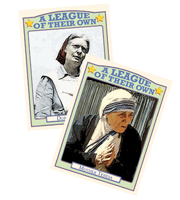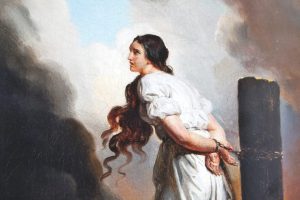Leading off is Mother Teresa, followed by Mom and Catherine of Siena. Batting cleanup is Mary. Readers have chosen an all-star lineup of saints, nuns, family members, and other holy women for the U.S. Catholic Reader Survey on inspirational women.
Of the men and women responding to the U.S. Catholic Reader Survey on inspirational women, 49 percent said the church offers good female role models to women and girls. Is this a positive statistic? Certainly those who responded, most of whom were women, sang the praises of women they admire, from their own mothers to the Mother of God.
But the statistic could also read that just 49 percent of readers think the church offers good female role models. Almost one third of respondents look to women outside the church for their inspiration. Less than half tend to be inspired by women in their parishes, female saints, women in the Bible, and prominent Catholic women. Two thirds worry that young women find the church lacking in female role models because not all leadership positions are open to women.
The issue seems to be not whether there are female role models, but how well these strong women are promoted within the church. "They are all over the place," a website visitor says. "We just need to be pointing our young women toward them."
For generations of girls the church's model woman was the traditionally obedient and submissive Mary. Although this image of Mary has lost favor since the feminist movement, a strong Mary continues to inspire readers who voted her as one of the most inspirational Catholic women.
Following God's will shows that Mary is courageous rather than submissive. She was an unwed mother, admired especially by modern mothers; she was a refugee; and she saw her son killed. We have to "get past the vision of a holy woman such as Mary as meek, quiet," Nancie Chmielewski of Milwaukee says. "I wonder if she really was meek?"
Another woman is just as popular as Mary among readers because she, too, combined humility with strength: Mother Teresa. News about the recent book (Mother Teresa: Come Be My Light, Doubleday) that documented her long crisis of faith has seemed only to increase readers' admiration of her.
"Although she felt that God was not listening to her prayers for years, she did not lose faith because she believed that faith is not a feeling but a gift," says Ana Marie Clemente Pinzón, a website visitor from Makati, Philippines.
The strength of her faith, though, is just part of what makes Mother Teresa inspiring; readers also admire what she did with it. "She chose to work with the poorest of the poor and continued to do so despite her own crisis of faith," says Laurice Bonannella of Budd Lake, New Jersey.
The most admirable group of women, earning esteem from 68 percent of readers, are women who work for peace and justice.
Working for justice within the church is the reason readers voted Sister Joan Chittister, O.S.B. by far the most inspirational woman currently alive. "She works for change from within the community she calls her home. She is an example of what it means to be on fire with the Spirit, loving her church so much that she can not sit quietly in the face of injustice," says Kaija DeWitt of White Bear Lake, Minnesota. DeWitt adds, however, that "some of the most inspiring women in the church today, Chittister first among them, are not touted as so by the hierarchy."
Inspirational Catholic women focus on others. What makes them commendable is "their relationship with God and how that relates to their relationship to others in the community," says a reader from Springfield, Virginia, reflecting on the two greatest commandments: Love God, and love your neighbor as yourself.
Women's relationships with others are also one reason readers list personal role models almost as often as they listed Mary or Mother Teresa. Family members and women in their parish inspire more readers than saints, biblical women, or public figures. "The women I encounter in my daily ministry use their personal experiences, good and bad, to help others with compassion, love, and justice. They empower the poor and marginalized to find their place in the community and church," says Mary Britanak of Seaside Park, New Jersey.
These women are lawyers, teachers, volunteers, lay ministers; they are nuns, sisters, mothers, and daughters. "She dares to be herself and is holy in doing so," says an Omaha, Nebraska mother of her 22-year-old daughter, who has studied in India and works to address hunger issues. "She is loving and creative and faith-filled, and she walks the talk."
When ordinary women "place into action the virtues of faith and love," as Ronald Hill of Aliso Viejo, California says of his wife, they become extraordinary role models.
Although an exceptional few women have gained fame while humbly serving God and neighbor, their focus on others is what hinders most female role models from having greater name recognition. "You can find plenty of female role models if you want to model women's work," says Terrance Brown of Charleston, South Carolina. "But you can't find them in real, public leadership positions."
The lack of women in church leadership worries the majority of readers. Lisa Ford of Albuquerque, New Mexico, who is inspired by women outside Catholicism, thinks the church's stance on women's ordination hurts it: "Women are leaving the Catholic Church and taking their love and talents to other denominations. The Catholic Church has made clear that it does not want female leadership, so it is not getting it."
Others respect the leadership roles that women currently hold, even if they are not priests. "While our female roles are different and limited, I don't think of them as less significant," says Jane Ross Laguna of Santa Ana, California.
Women religious, Sandy Calabro of North Stonington, Connecticut says, are "one of the church's greatest resources. I am inspired by their faithfulness, vision, and level of education." But their numbers are dwindling.
"Many parishes don't have nuns to offer inspiration," says Dianne Keller Smith of Columbus, Ohio. She adds, "My feminist daughter wants to be pope," not a nun. Smith's 15-year-old daughter doesn't consider herself Catholic because of the issue of women's ordination. Smith, however, remains Catholic because other women have taught her "that the Catholic Church has a beautiful, complex history. If I disagree with anything, I could leave, but the best way is to work within the church to make changes."
Beyond Mary, Mother Teresa, Chittister, and a few other notable names and saints, women may not always be recognized for the work that they do for society and the church. Women who are strong in their own faith, however, play the most important role in the church: They are the torch-bearers of the faith, passing it to the next generation of Catholics. As a Web visitor says: "Face it, in most households it's the woman who drags us to Mass."













Add comment